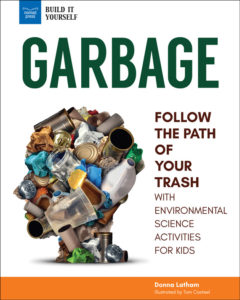“Talking Trash!”
Life with kids is pretty busy, and it can be easy to forget to consider the environment with every purchase we make. Bottled water, individual snack packages, and upgraded devices all seem like the standard price we pay for being parents and educators in modern society, but in fact, the garbage we produce from this lifestyle has an impact that lasts far longer than—or just as long as—a laminated piece of child’s artwork.
What have you tossed in the trash today? A gnawed apple core? A plastic straw? A tattered handbag? A piece of furniture?
We throw tons of garbage away every day. Anywhere you find people, you’ll find garbage—mounds and mounds of it. A gyre of plastic trash floats in the middle of the ocean. Garbage is even marooned on the surface of the moon.
Usually, we don’t realize how much stuff we throw away. In just one year, an average family of four in the United States churns out 6,351 pounds of waste. That’s enough to fill a three-bedroom house to the ceiling.
And where does all that trash go? It doesn’t simply disappear, as much as we’d like to think so. Even the stuff that gets lugged to the landfill requires a careful process of sorting and arranging so that the runoff and off-gassing doesn’t make us ill. Or it might get burned and filtered to reduce the amount of toxins that are released into the atmosphere.
But still—our oceans fill with plastic, which gets eaten by marine life. Our highways and back roads are lined with litter. Our beaches are minefields of trash.
However! Through effort and education, we can make a difference and be part of the cleanup. And we owe it to our kids to model behaviors that will result in positive changes to the world—such as reducing the amount of trash we create! While the three R’s of Reduce, Reuse, and Recycle are critical in our quest to make Earth healthy, there’s another R of equal importance—Rethink. Rethink the way you make purchases and the way you use what you have. This is an incredibly important lesson for kids to see acted out on a daily basis.
To help, try these environmental activities with the children in your life!
TRACK YOUR TRASH
What’s in your rubbish? For one week, track and record every item your family discards. Be very careful because trash can contain broken or sharp objects.
- Use a scale to weigh three large empty plastic tubs. Record the weights in a science journal.
- Reuse cardboard, index cards, or scratch paper to make three labels for the tubs: “Trash,” “Reusable,” “Recyclable.” Attach the labels to the tubs.
- For one week, become your family’s garbage collector. Put on rubber gloves to rummage through every item of trash. Be on the lookout for broken or sharp items and handle with care. Categorize each as trash, reusable, or recyclable. Place each article in the appropriate container.
- At the end of the week, weigh each tub of stuff. Subtract the original weight of the empty tub from the total and record how much waste each tub has.
- Compare and contrast your totals with those published by the EPA. Did each person in your household produce about 31. pounds of garbage, which is the national average?
- Challenge your family to cut down your amount of garbage. Rethink your trash choices. What can you reuse or recycle, instead of discarding? If you get a composter, you can compost food waste.
- A month from now, try this activity again to observe your success. Are your results different?
TO DYE FOR!
Has your old T-shirt seen better days? No need to let it die. Dye it instead! Next time your family boils colorful veggies, don’t dump the water. Use it to brew natural dyes the way colonists and pioneers did. Then, use those dyes to jazz up your shirt and give it new life.
Choose your color. Beets will make red. Carrots produce orange. Gold onions make yellow, red cabbage produces purple, and spinach gives you green. Put the vegetables in a pot, cover with water, and boil them. Drain the liquid and strain out any solid bits. Store the liquid in a glass jar until you’re ready to dye the shirt.
Before you use your colored liquid, you’ll need to make sure the dye will set in the fabric. Pour 4 cups of cold water and 1 cup of vinegar into a large pot. Place the T-shirt into the mixture. Then, put the pot on the stove and simmer the shirt for a full hour. Check on it now and then to make sure the mixture doesn’t boil away. After an hour, remove the shirt and rinse it in cold water.
Now you’re ready to work with your dye. Return the pot and T-shirt to the stove and pour in the colored water. Simmer again. When you are happy with the color of the shirt, turn off the heat. Wear rubber gloves to handle the shirt because dye stains skin. The color will dry a few shades lighter than it looks in the pot. Hint: When it’s time to launder your shirt, wash it separately in cold water. The dye will last longer and won’t stain anything else.
JUNK MAIL BEAD NECKLACE
It’s fun to get a card or package in the mail. But junk mail? Not so much. You don’t ask for junk mail, but it shows up anyway. It’s usually advertising materials such as catalogs, flyers, credit card applications, and even CDs. One credit card company sends out materials in a fancy gold box with a plastic window, two Styrofoam bumpers, and five individual flyers inside! According to the New York University School of Law, most families in the United States receive 848 pieces of junk mail annually. About 46 percent is never even opened. Many people toss it straight into the trash, so about 5.6 million tons of the stuff clogs landfills.
Reuse junk mail to create colorful trash-to-treasure paper beads for a necklace.
Hint: Reuse clasps from broken jewelry. You can also string pearls, beads, and charms along with your completed paper beads.
Collect all the mail your family receives for one week. Make one pile of regular mail and one of junk mail. Tally the number of pieces in each, and record your totals in your science journal. Weigh each pile and jot down those totals. How do they compare?
Place the junk mail into categories of your choice. For example, make piles of catalogs, advertisements, flyers, or magazine subscription offers. How many pieces are in each pile? Note your findings.
Now it’s time to reuse! First decide how long you’d like your necklace to be. Measure a length of thin cord or fishing line and cut it.
Create a template with a piece of cardboard. Draw a triangular shape 1 inch wide at its base and 6 inches long. Cut out the template and use it to trace about 30 strips on glossy paper from your junk mail. Cut out the strips. If you discover later that you need more beads, then come back to this step.
Firmly wrap the wide end of the first strip around a wooden skewer or chopstick and roll the strip toward the pointed end. The tighter the paper, the more decorative the bead. When you have about 2 inches of bead left to roll, use a glue stick to swipe the remaining length.
Finish rolling the bead and hold it firmly in place until the glue sets. Carefully remove the bead from the stick and set aside. Repeat with all the strips until you’ve made all the beads.
For strong, durable beads, seal them with a coat of decoupage glue, or Elmer’s glue with water added. This makes a nice finish. You might find it’s easier to apply glue if you place each bead back on the skewer tip first. After applying the glue, set each bead aside to dry.
Tightly tie a metal clasp to an end of the fishing line. When the beads are dried and feel firm to the touch, string them on the line. Once the line is completely full, tightly attach the other clasp. Enjoy your junk mail jewelry!
Discussion questions:
Why does it matter where our garbage goes after we throw it out?
Do you produce more inorganic or organic waste?
How has garbage dumping changed throughout history?
What role do landfills play in solid-waste management?
How does hazardous waste cause problems in landfills and the environment?
How will you recycle and reduce to limit what you dump into the waste stream?
How can you use creativity and ingenuity to reuse items?
How will you challenge yourself to recycle more?
How can you rethink choices to develop a waste-reduction action plan?
About the Author: Donna Latham is an award-winning author and playwright. She is the author of Amazing Biome Projects You Can Build Yourself, Backyard Biology Investigate Habitats Outside Your Door With 25 Projects, Deciduous, Forests, Deserts, Garbage Investigate What Happens When You Throw It Out With 25 Projects, Norah Jones, Oceans, Respiration and Photosynthesis, Savannas and Grasslands, and Tundra. She is a member of the Society of Children’s Book Writers and Illustrators and the Society of Midland Authors. She lives in Batavia, Illinois. Website: donnalatham.com
About the Book: That potato chip bag you tossed in your trash can this afternoon—where does it go when it leaves your house?
Garbage: Follow the Path of Your Trash with Environmental Science Activities for Kids invites middle graders to investigate the world of trash! The average American produces more than four pounds of trash every day—multiply that by 300 million people and you’ve got a lot of garbage! Where does it go? How does it break down? What are the challenges of dealing with so much waste? What can we do decrease the amount of stuff we are throwing away? Garbage explores questions like these while encouraging kids to think about the choices they make that generate garbage in the first place.
Try these hands-on environmental projects!
- Investigate a mini midden
- String a junk mail bead necklace
- Snag air pollution on a stick-it can
More information including free teacher resources at https://nomadpress.net/nomadpress-books/garbage/
Thank you to Donna for her important and thought-provoking post!


